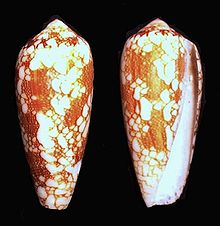- Conus pennaceus
-
Conus pennaceus 
Scientific classification Kingdom: Animalia Phylum: Mollusca Class: Gastropoda (unranked): clade Caenogastropoda
clade Hypsogastropoda
clade NeogastropodaSuperfamily: Conoidea Family: Conidae Subfamily: Coninae Genus: Conus Species: C. pennaceus Binomial name Conus pennaceus
Born, 1778 [1]Synonyms[2] - Conus aureus Röding, P.F., 1798
- Conus bazarutensis Fernades & Monteiro, 1988
- Conus behelokensis Lauer, 1989
- Conus colubrinus Lamarck, 1810
- Conus elisae Kiener, 1850
- Conus episcopus Hwass in Bruguière, 1792
- Conus episcopus mauritiensis Lauer, 1992
- Conus ganensis Delsaerdt, 1988
- Conus marmoricolor Melvill, 1900
- Conus mauritiensis Lauer, 1992
- Conus omaria var. marmoricolor Melvill, 1900
- Conus pennaceus bazarutensis Fernandes & Monteiro, 1988
- Conus pennaceus corbieri Blöcher, 1994
- Conus pennaceus tsara Korn, Niederhöfer & Blöcher, 2000
- Conus pennaceus vezoi Korn, Niederhöfer & Blöcher, 2000
- Conus praelatus Hwass in Bruguière, 1792
- Conus purus Pease, W.H., 1863, "1862"
- Conus quasimagnificus Reeve, 1843
- Conus racemosus G. B. Sowerby II, 1874
- Conus rubiginosus Hwass in Bruguière, 1792
- Conus rubropennatus Da Motta, 1982
- Conus sindon Reeve, 1844
- Conus stellatus Kiener, 1845
- Cucullus gentilis Röding, 1798
- Darioconus pennaceus (Born, 1778)
Conus pennaceus, common name the feathered cone, is a species of sea snail, a marine gastropod mollusk in the family Conidae, the cone snails and their allies.[2]
Like all species within the genus Conus, these snails are predatory and venomous. They are capable of "stinging" humans, therefore live ones should be handled carefully or not at all.
There are two subspecies :
- Conus pennaceus behelokensis Lauer, 1989
- Conus pennaceus echo Lauer, 1988
Contents
Description
The size of an adul shell varies between 35 mm and 88 mm. The color of the shell varies from orange-brown to chocolate, covered by minute white spots, and overlaid by larger white triangular spots, sometimes forming bands at the shoulder, middle and base. [3]
Distribution
This species occurs in the Red Sea, in the Indian Ocean along Madagascar, the Mascarene Basin and Tanzania; in the Pacific Ocean along Hawaii.
References
- ^ Born, I. von, 1778. Index Rerum Naturalium Musei Caesarei Vindobonensis. Pars Prima, Testacea.
- ^ a b Conus pennaceus Born, 1778. Accessed through: World Register of Marine Species at http://www.marinespecies.org/aphia.php?p=taxdetails&id=215500 on 19 July 2011.
- ^ George Washington Tryon, Manual of Conchology vol. VI, p. 93; 1879
- Vine, P. (1986). Red Sea Invertebrates. Immel Publishing, London. 224 pp
- Filmer R.M. (2001). A Catalogue of Nomenclature and Taxonomy in the Living Conidae 1758 - 1998. Backhuys Publishers, Leiden. 388pp.
- Tucker J.K. (2009). Recent cone species database. September 4th 2009 Edition
- Filmer R.M. (2001). A Catalogue of Nomenclature and Taxonomy in the Living Conidae 1758 - 1998. Backhuys Publishers, Leiden. 388pp
External links
Categories:- Conus
- Animals described in 1778
Wikimedia Foundation. 2010.
